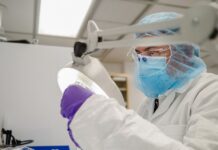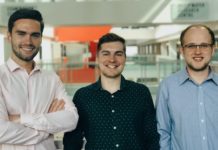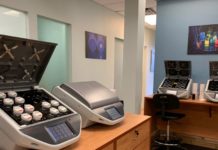Put together two inductors and you get a transformer; put two old friends together at Innovation Park and you get something equally transformative.
Doug Malcolm and Yan-Fei Liu had met and become good friends back in the 1990s, while working in Nortel’s power group in Ottawa. When the company disbanded it, they went their separate ways – Liu (a Queen’s PhD) back to Kingston, to become a professor with the university’s Department of Electrical and Computer Engineering, Malcolm ultimately to Sumida, the Japanese manufacturer of inductors and other coilbased technologies.
A chance meeting at a conference in Dallas in 2011 got them together again. Over lunch, an idea took form. Liu had a problem with inductors, the key element that enables the charger in a phone or computer to take a flow of electricity and reduce its voltage, from 120 volts to 12 in the case of your computer’s power supply, for example, or from 3.7 in your cell phone battery down to 0.8. The challenge? “Your cell phone charger now is much, much smaller than the one that came with your first or second cell phone,” he says. “We want everything smaller.” Inductors have resisted this trend. You can shrink an inductor by making it higher frequency, but this creates a problem with power loss. It also creates tremendous heat, which can affect the operations of the device or computer. This is why large groups of servers are kept in special air-conditioned rooms.
Thinking about this challenge, Malcolm and Liu came up with a novel solution. Don’t try to make the inductor smaller. Make it slightly larger – and then bury all the other components inside it. The end result would be a power supply that isn’t as big as before, but doesn’t suffer from the drawbacks of high-frequency inductors. Together, they approached Malcolm’s boss in Chicago with the idea and got the go-ahead to launch a Sumida R&D project – a rarity in North America.
Because Liu was at Queen’s, and Malcolm was anxious to return to Canada after many years away, they chose Kingston. The company got off the ground in January 2013, and the two men headed out to search for empty space for rent on a winter’s day.
“We started driving around looking for a storefront, says Malcolm. “It was a snowy day. Out the window, I could see Innovation Park, and the minute I saw it, I liked it.”
They quickly learned that Innovation Park offered more than any empty storefront. They were able to set up shop right away, and quickly tap into a network of useful connections. Rick Boswell, the Assistant Director at Innovation Park and their “landlord,” helped them apply for a Natural Sciences and Engineering Research Council of Canada (NSERC) grant to cover the cost of a student to work in their lab. In August 2014, they also received a Collaborative Research and Development grant from NSERC, intended to underwrite mutually beneficial cooperative projects between university researchers and their private sector partners that benefit Canada economically.
Malcolm and Liu have been granted a patent for their innovation, and they have five or six more pending. They are working to expand their power supply in inductor model to work with different voltages and currents. Commercial interest in their idea is strong, and they have recently hired a marketing director to help them sell their product. All told, they have eight employees, six in Kingston at Innovation Park and two in Ottawa. Three of their employees are Queen’s grads. That’s a plus of the Kingston location. “It is easier to recruit someone who is already here,” says Malcolm. The company currently also has a Queen’s PhD working in its lab, and Sumida recently hired another student on a year-long co-op program.
A rekindled friendship, a chance sighting of the ideal space for their company, it seems in a way so casual a start to a successful firm. But as Steven Liss, Queen’s Vice-Principal (Research), says, “Business sometimes works that way. The important thing is to provide a framework where these informal relationships and lucky connections can grow into something lasting.”
















